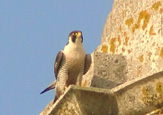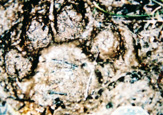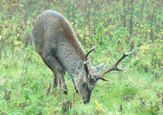





The Natural Stuff - Big Cat Paw Prints
The spoor of cats are usually quite different to that of dogs although there can be great confusion for a variety of reasons. Basically both felids and canids have four visible toe pads and a hind or planter pad. Both feet are anatomically similar but it is the arrangement of the toe pads, the shape and the planter pad that determine as to whether they are from a cat or a dog.
Paw prints typical of large leopard like cats
Click the photos for a larger view.
Prints are not easy to find from cats. This is because cats are more careful in where they walk unlike a dog that will walk through a patch of mud; a cat will go out of its way to avoid it. Cats hunt by stealth and creep around yet a dog is basically a wolf that runs with the pack so they do not hide to the same extent that a cat does. Cats like to remain clean also, and are fastidious cleaners. A patch of mud along a path for instance will reveal many dog tracks, but is unlikely to show a cat, as the can would have walked around the puddle, as a general rule, so if a cat spoor has been found in the mud, then that is uncommon.
There are so many dogs about that tracking cats become very difficult. Many dog prints are very similar to some cats and tracks found that are at odd angles or partly revealed can be a problem, There is also a problem in that some cats feet are more dog like than other species, or maybe there hind feet are similar to a dogs, or that a particular breed of dog has feet similar to a cat if they are splayed out in the mud for example. There is a general rule that applies, but is not always consistent, and that is, if it shows claw marks then it is a dog.
This usually applies but is not always the case as some dogs do not show claw marks and some cats do especially when walking along a slippery path or if an animal has just landed from a jump, or if inbreeding has been taking place then arthritis may prevent a cat from sheathing its claws, or it may be that certain hybrid cats may not be able to sheath there claws at all. This is a possibility so cannot be ruled out. There are many prints found by myself and other people that show the typical cat characteristics but also show claw marks. The basic characteristics of a cat’s foot are:
Three up one down. That means, like our own figure arrangement. View your own hand in front of you. Hold the hand out with fingers erect or make a fist, then push up the fingers but keep the top joints bent in. Look at the arrangement. From the edge of the hand the digits grade upwards for three fingers then down one. This is the typical three up and one down of the arrangement of most cats paws. Different species of cats have slight variations and some have a more angled hind foot than the fore, or vice versa. But one thing that a dog rarely has is the three up and one down arrangement. So if you are out and see a distinct three up and one down, then the chances of it being a cat are high. These are other factors to consider as well. The feet of cats are generally broad, or at least broader than they are long, this is consistent with most species, especially the fore feet. This does also apply to most dogs. Also the individual digits are splayed out more than a dog, but a galloping dog splays its foot and may look similar in shape to that of a normal walking cat.
Some prints look very much like big male leopard, or even jaguar
The toe pads of most cats are of unequal size and it shows in prints, and they are also elongated and not so rounded off as most dogs are. The fourth digit is also adrift in most cat species and this trait also usually shows. The pads’ of dogs hug the planter pad more so than a cat’s.
The rear edged part of the planter pad of a cat is usually three lobed as opposed to the bi lobed hind edge of a dog’s, and it is much larger and broader. There are exceptions to this rule, and a look at the rear foot of a domestic cat will show that the shape is basically oblong like a dogs and the two top toes are at equal level, similar to that of a dog, but one look at the elongated pads, almost bean shape, and more importantly the typical three lobed rear edge of the planter pad is diagnostic. A rear foot of a leopard may look very dog like, but a puma does not, and if there are super sized feral cats then a domestic cat’s print will be the size of a medium dog. It is best to find a long stretch of footprints in mud, sand or snow to get a better picture, as there are differences in the way cats and dogs walk, the distance between strides and direct register, that is the hind foot being placed on top of the print of the fore foot, as most cats will do when walking at a leisurely pace. The track will show a row of fore foot toes with the hind foot toes directly underneath without the fore foot planter pad showing. Dogs rarely do this and the hind foot is usually ajar at an angle not toughing the fore foot print at all.
Most dog prints show up large claw impressions. Dogs have broad bluntish claws and they nearly always show in prints. A dot a short distance away from the edge of the top toe pads is usually visible, though a cat print can sometimes reveal this but the cats claw is very different from that of a dog, it is thin and sharp, so if they do show, they are slits and can be seen to immerge from the top of the toe, as they are not bent as much as a dogs. Dogs usually have blunt or squared off ends to the claws also. Below are some typical pug marks of both dogs and large cats. All of these pictures were taken by me in Dorset.















